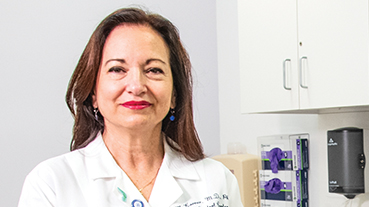Managing the Challenges of Pregnancy and Diabetes

Dr. Felicia A. Mendelsohn Curanaj
As the prevalence of diabetes continues to rise around the world, so, too, does diabetes in pregnancy, a clinical focus of Felicia A. Mendelsohn Curanaj, MD, Director of the Inpatient Glycemic Management Program at NewYork-Presbyterian/
“The risk of maternal and fetal morbidity is increased in someone with diabetes who is pregnant,” says Dr. Mendelsohn Curanaj. “This includes those who develop gestational diabetes as well as those with type 1 or type 2 diabetes prior to becoming pregnant."
“Our goal is to improve glycemic management during pregnancy to reduce the risk of adverse outcomes to both mom and baby. Serious complications, such as macrosomia, an increased need for an operative delivery, birth trauma, and even newborn hypoglycemia after birth can be prevented,” explains Dr. Mendelsohn Curanaj. “Hyperglycemia in the first trimester of pregnancy is associated with higher rates of a wide range of congenital malformations in the baby. A number of studies have even linked maternal hyperglycemia with longterm obesity and diabetes in the child later in life.”
Several tests identify gestational diabetes, including the one-hour glucose challenge test, which is performed between 24 and 28 weeks gestation in most patients. A woman is given 50 grams of oral glucose, and plasma glucose is measured one hour later. If that test comes back abnormal, it is followed up by a three-hour, 100-gram glucose tolerance test.
Women with either type 1 or type 2 diabetes considering pregnancy should begin by focusing on glycemic management and a healthy lifestyle prior to becoming pregnant, notes Dr. Mendelsohn Curanaj, who stresses the need for close monitoring of glucose levels. “We will work with the woman ahead of time so that we can reduce risks and improve outcomes for both her and her baby. We can use continuous glucose monitoring [CGM] systems that measure the glucose level of subcutaneous interstitial fluid throughout the day and night. Some devices have predictive alarms to alert patients of impending hypoglycemia based on glycemic trends. This allows patients to actually prevent hypoglycemia, rather than react to an event that has already occurred. CGMs have been shown to reduce hemoglobin A1c, reduce time in hypo- and hyperglycemia ranges, and improve neonatal outcomes.”
| Gestational Diabetes or Pre-Existing Type 1 or Type 2 Diabetes Mellitus | Treatment Goal |
|---|---|
| Preprandial glucose, mg/dl | < 95 |
| 1-Hour Postprandial glucose, mg/dl | < 140 |
| 2-Hour Postprandial glucose, mg/dl | < 120 |
“Given that the recommendation for pregnant women with diabetes is to check their blood glucose levels four to eight times per day, and that there is a significant risk for hypo- and hyperglycemia due to mounting insulin resistance during pregnancy, CGMs are helpful to achieve glycemic goals during this challenging time,” says Dr. Mendelsohn Curanaj. “Maintaining in-target glucose levels during pregnancy is essential — the recommended targets for glucose management are even lower than they would be outside of pregnancy.” [See Table 1]
According to Dr. Mendelsohn Curanaj, any woman who has had gestational diabetes also has her own increased risk of developing type 2 diabetes later in life. “About 50 to 70 percent of women with gestational diabetes will go on to develop type 2 diabetes sometime in the next 25 years of their life.
It is important to continue following these women to monitor them for the development of diabetes and to help them maintain a healthy lifestyle that includes planning meals and regular physical activity.”
In the August 2018 issue of Current Diabetes Reports, Dr. Mendelsohn Curanaj, Dr. Tiffany Yeh, and Dr. Michele Yeung at Weill Cornell Medicine published a review of the literature regarding inpatient glycemic management of the pregnant patient. Based on published guidelines from various societies, they reviewed the diagnostic criteria for diabetes in pregnancy; types of therapies available to prevent hyperglycemia; and strategies for reaching inpatient glycemic targets during the peripartum period.
| Weeks | Description |
|---|---|
| < 9 weeks gestation | insulin requirements increase |
| < 10-14 weeks gestation | period of increased insulin sensitivity; insulin dosage may need to be reduced accordingly |
| < 14-35 weeks gestation | insulin requirements typically increase steadily |
| < 35 weeks gestation | insulin requirements may level off or even decline |
“Caring for pregnant patients with type 1 diabetes is especially challenging as insulin sensitivity fluctuates throughout pregnancy due to physiologic changes, particularly during labor and delivery and immediately postpartum,” says Dr. Mendelsohn Curanaj. “Providers should be aware of the varying insulin requirements at different stages of pregnancy and how to reduce hypoglycemia and avoid diabetic ketoacidosis [DKA].” [See Table 2]
Dr. Mendelsohn Curanaj stresses the need for collaboration among the patient, her endocrinologist, obstetrician, and diabetes educator/dietitian. “Management involves a combination of medical nutrition therapy, physical activity if medically appropriate, and pharmacologic agents if needed. Guided by an interdisciplinary team with in-depth knowledge of the latest management principles, it is possible to achieve euglycemia during this critical time of a mother and baby’s life.”
Reference Article
Yeh T, Yeung M, Mendelsohn Curanaj FA. Inpatient glycemic management of the pregnant patient. Current Diabetes Reports. 2018 Aug 15;18(10):73.
Related Publications




